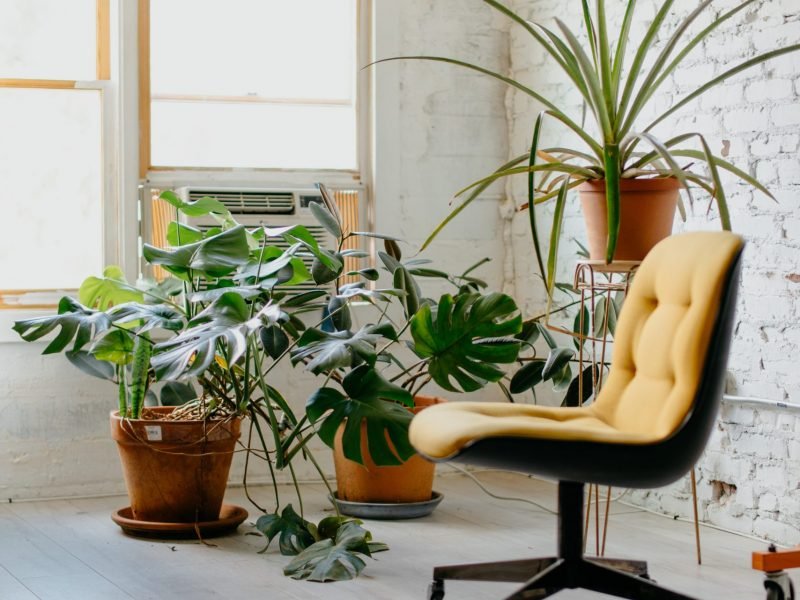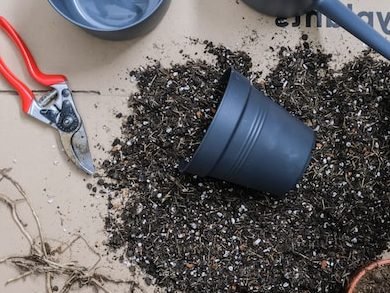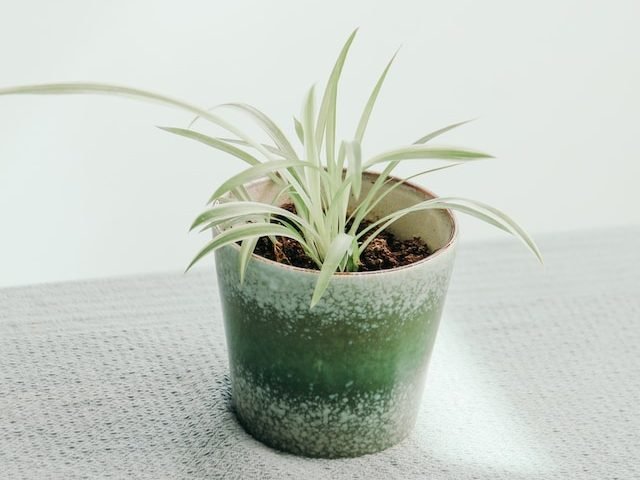
Whether you have returned to the office after a long holiday to find the plants in need of some more love, or if you have simply forgotten about them in a mix of conference calls and spreadsheets, we have all the needed tips and tricks to bring your office plants back to full health.
The main things to attend to are: watering, leaf care, checking its environment, increasing humidity and replacing some of the soil.
Correct watering can help revive your dying office plants
Firstly, double-check that it actually needs watering and that your colleague hasn’t secretly been overwatering it like crazy. If your plant has developed dry and brown leaves and the soil is light and dry, chances are your plant definitely needs a watering. But before you quickly give your dying plant a bucket load of water, hold off for a second as there are some special techniques that will help get your plant looking and feeling healthier.
Try and locate a bucket of some sort (this may be difficult in your office situation but an empty bin or something would do the trick) and fill it with water. Soak your plant for around 20-30 minutes before letting it drip dry back in its pot and saucer. Then continue to water it little and often over the course of the next week or two before taking up a normal care routine once again.
Soaking is super important when reviving a dying and neglected houseplant. It works a lot better than just giving it a lot of water as the water will run out into the saucer straight away and leave the root system just as dry. So you want to make sure that the whole soil is moist throughout.
Proper leaf care can help save a dying houseplant
It is also really important to not only focus on the roots when trying to revive the plant, but also giving the leaves some needed TLC. Start by gently wiping the leaves down with soapy warm water to remove dust build up. This is really important to allow the plant to photosynthesise fully again and also leaves them looking shiny and brighter.
It is also a good idea to give the leaves a once over to check for any pests or signs of further problems which we touch on a little more below.
Increase the humidity to save your dying plant
Alongside watering, it is important that you try and increase the humidity for your plants as offices can have quite dry recirculated air. This can be especially damaging in winter months when we often have the heating on all day, every day. A lack of humidity in the air can cause the leaves to be a little limp and droop down. These are the best and easiest way to increase the humidity for your office plants:
Misting the leaves
One of the simplest ways to increase the humidity for your office plants is to mist them with a spray bottle a couple of times a week.
Pebble tray
Place your houseplants over a tray of pebbles with fresh water over the top. Over the day water from the tray will evaporate giving the plants above exactly what they’re looking for.
Buy a humidifier
They are relatively affordable little devices and they make keeping a consistent humidity level so much easier. Most will allow you to place them on a timer so they run on a fixed schedule, and some will even have a built-in monitor so they automatically turn on and off to keep the humidity exactly where you want it.
Want to know more about how to raise the humidity for your plants? We have written a whole guide on this.
Check the environment
Whilst this can’t undo any of the damage caused to the plant already, making sure that the plants are in their ideal environment is important to help it regain strength and healthy growth.
Check the lighting conditions
If your plant has been left near a window for long periods of time, it may be receiving too much direct sunshine (especially over the warmer months). If you spot bleached, burnt-like patches on the leaf then it may need to be moved further inside the office, away from the windows.
If your plants were left in dark corners of the office, and are producing small spindly growth, chances are it needs more light to thrive. In this case, move it to a sunnier spot but be careful of direct sunshine if that plant type doesn’t like it too much.
You can check over the specific care guides for your plant over in our Plant Index.
Check for heating/AC vents
Radiators, heating vents or AC systems can be quite harmful to your plant as they create extreme temperatures and drafts. Check with your building manager to see if the heating and AC vents are turned off at all on evenings and weekends. If they are always on (which for most offices they probably will be) then you might need to re-think where you place your plants. You want them to be close to natural sources of sunlight, but never directly below a vent or next to a radiator.
Check for pests
One thing to look out for when giving the leaves a once over is pests. It can happen that pests such as mealybugs, spider mites, scale insects and more can take hold of your plants.
If you find pests on your plants we recommend wiping down the leaves with soapy warm water and washing the soil once through. If it is easier you can also replace all of the soil to get rid of the pests. You should treat your plant with an organic insecticide to fight the infestation alongside these other methods.
Make sure to check over your other plants in the office to see if any other plants have pests. Keep your infected plants a good distance away from any of your other office plants as you don’t want the pests to spread.
Repotting can help to save a dying houseplant
Another way to give your office plants some love is to repot them into fresh soil. This wouldn’t be a good idea for the first week or two of trying to revive the plant as this may cause some shock so it is better to leave the plant for about two weeks of good care in an ideal light environment before repotting.
When you do replace the soil, make sure to gently rub all the old soil from the root system by running your fingers through it. Don’t be alarmed if some of the roots come with the soil, this is natural and they will regrow pretty quickly. If you notice that some of the roots are rotted and dying, snip these away with some clean scissors.
Stay away from fertiliser if your plant is dying
There is some mixed opinion on whether fertilisation is a good idea or not when trying to revive the plant, but we steer clear of it. You don’t want to shock the plant into trying to produce rapid new growth so it is best to wait at least a month before adding in some water-based fertiliser. You want to make sure that the roots and soil is moist and the plant is in the right environment before fertilising.
Reviving your plants can be difficult, especially if they have been neglected for long periods of time. If you find yourself out of the office quite a bit and unable to give regular care to your plants, it is worth looking into low-care houseplants as some really do thrive from being neglected. Don’t give up on your plants too quickly, they may look pretty dead but will actually start to grow again with the right care. So be patient, treat them well and they may reward you with new healthy leaves!















